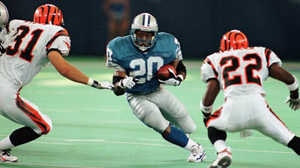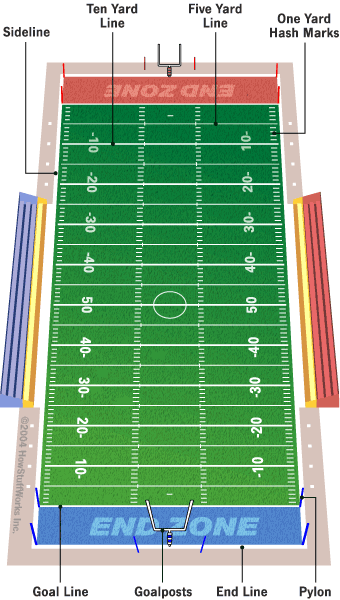BenchFly’s Football Primer: Science-ized
by
 Given the number of rules, American football can be a confusing and intimidating game if you’re new to the sport. As a result, many times the easiest solution is simply not to watch the game – with one exception: The Superbowl.
Given the number of rules, American football can be a confusing and intimidating game if you’re new to the sport. As a result, many times the easiest solution is simply not to watch the game – with one exception: The Superbowl.
With an average audience size of roughly 90 million people, it’s nearly a cultural holy day. Over the years, I’ve watched the game with scientist friends from almost every continent and in all cases, understanding a few basic rules made a huge difference in their enjoyment of the game.
So we at BenchFly thought a quick football primer may be in order- in the language we all speak- science… The goal is not necessarily to create fans of American football, but we figure if you’re going to sit in front of a tv for six hours, you might as well know when to yell at it.
The Game
A football game is broken into four quarters. Each quarter is fifteen minutes long and the second and third quarters are separated by half-time- 30 minutes where a lame acts put on a lame show.
Science-ized: Consider a game to be like graduate school. The first quarter is filled with excitement and anticipation for all of the action to come. By the second quarter, the charm has worn off and reality has set in- this thing’s gonna take a while. The third year of grad school is not unlike being the band that plays the halftime show- it’s a prolonged period of time where nobody pays much attention to you. By the fourth quarter (fifth year of school), everyone’s tired, has a bit of a headache and just wants to go. You hope the end is exciting, but usually it just hurts.
The Object
To score more points than the other team. Points can be accumulated by scoring touchdowns or kicking field goals (see below).
Science-ized: Imagine two assistant professors in a department with one tenured position available. There can only be one winner.
Touchdown
When a team has the ball, they are on “offense.” The offensive team’s goal is to move the ball all the way to the end of the field to an area called the “end zone.” The other team, the “defense,” is trying to prevent them from doing that. If the offensive team gets the ball to the end of the field, it’s called a touchdown and they are awarded six points.
Science-ized: Scoring a touchdown is like getting a paper accepted. It’s the most valuable reward for a lot of hard work. Think back to the excitement of opening your last publication acceptance email. Now you understand the touchdown celebrations. Take note of the various celebratory dances during the game and apply after next paper.
Extra Point
After a team scores a touchdown, they will send the kicker out to attempt an extra point. The kicker tries to put the ball in between the vertical yellow poles (“goal posts”) and if they do, the offensive team will be awarded an additional one point. Because they’re so routine, teams rarely miss extra points. This is why touchdowns will be talked about as seven points (6 + 1) by tv announcers and the know-it-all at the party.
Science-ized: It’s like turning in your revised manuscript after it was “accepted with revisions.” You assume it’s good. It should be good. If it isn’t and more work is required- anger may ensue.

Diagram of an American football field. If you're a Detroit Lions fan, take note of the location of the End Zones, you've probably never seen them before...
First Down
When the offensive team gets the ball, they will get four tries to move the ball 10 yards (unit of measurement) closer to the end zone from where they started. Each try is called a “down.” On tv, the 10-yard distance is marked by a virtual yellow line that crosses the field. Each time the offensive team moves the ball 10 yards, they are awarded a first down, and the process starts over again.
If they fail three times in a row, they will be faced with their “fourth down.” If they decide to try again on their fourth down and they fail again, the other team gets the ball at that spot on the field. On the other hand, if the team decides they can’t do it on the fourth down, they will send in a kicker to punt (see below). This is a way of transferring the ball to the other team that puts them much farther away from the end zone.
Science-ized: When starting a project, we all hope it ends up as a paper. However, we don’t know until we start doing experiments. A first down is like getting a result that convinces your PI to let you keep working on the project a little longer. As long as you can come up with a good result every four experiments, they’ll let you keep working toward the paper. Like good results, first downs are important and are worth cheering about.
Punt
As described above, on fourth down if a team decides they can’t move the ball 10 yards, they will send in a scrawny guy with a big helmet (the kicker) to punt the ball away. The other team will catch the ball and try to run towards the endzone.
Science-ized: You’ve spent two months on a project and you just don’t believe it will work. You have a quick talk with your boss and pull the plug on the project. Maybe you “punt” it to a new grad student who doesn’t know any better… Either way, it’s off your plate.
Field Goal
When an offensive team is close to the end zone, but it’s fourth down, they may be close enough for their kicker to kick the ball through the goal posts instead of punting. If he does it successfully, this is called a field goal and the offensive team will get three points.
Science-ized: This is like getting published in a horrible journal. People are relieved to have gotten something out of the project, but nobody really wanted that. They wanted a touchdown.
The field goal kicker is like a technician. They are hired to do a specific set of tasks and it’s assumed they will get them right every time. However, when a field goal kicker misses, it’s like finding out that the tech read the buffer recipe wrong and added 8M urea instead of 5M sodium chloride- inexcusable. Head’s will roll.
Interception
When the quarterback throws the ball in the air and the other team (the defense) catches it. This means the team that caught the ball will now be on offense (trying to take the ball to the end zone).
Science-ized: Your competitor saw some of the experiments you were doing and knew exactly where you were going with the project. So they went ahead and completed it faster and took away your project. Interceptions kill momentum and make you angry at the other team. It’s like football’s version of getting scooped.
There are an insane number of rules in football that can take many years and many beers to learn. However, with these rules in toe, we hope we’ve at least prevented a “home run!” cheer late in the game…
.
How would you define the quarterback? Are they the PI, or is that the coach?…
.


whizkid
wrote on February 5, 2010 at 3:12 pm
My PI is definitely the coach- stands around looking angry most of the time and then takes more credit than he deserves when things go well…
Peter B. Madrid
wrote on February 6, 2010 at 1:38 am
Alan, I like that you managed to sneak a picture of Barry Sanders into this post. I'm sure as a Lion's fan you have to live in the past, like us 49ers fans do now. A very nice synopsis though. I have also tried to explain the game to many European post-docs, but they still complain about why there are so many stops in the game. Then I have to explain that un-like soccer, there is actually a lot of strategy and people are not just running around in circles.
Alan Marnett
wrote on February 6, 2010 at 6:19 pm
Anytime I can work the glory days of Lions football into a post, I'm on it. And by "glory days" I mean any game with Barry Sanders. I read a stat the other day that said on average, from snapped ball to tackle, there are only 11 minutes of total action in a football game – so I can understand the complaints about all of the stoppages. Of course, I choose to look at the stoppages as drink breaks…